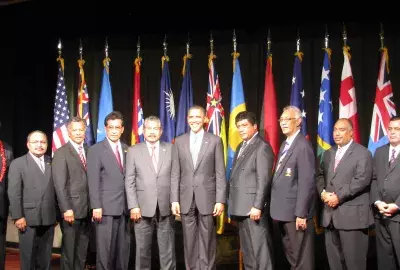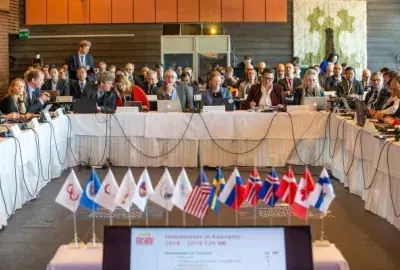Error message
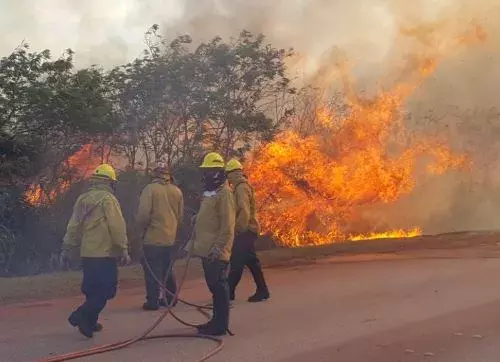
OFFICE/DEPARTMENT
HONOLULU (April 7, 2021) -- Even as the COVID-19 pandemic remains the focus in the Pacific, compound threats increase the need for regional cooperation to address the mounting economic and environmental impacts from climate change, according to panelists at a recent East-West Center workshop on “Strengthening Resilience, Cooperation, and Partnership in the Pacific.”
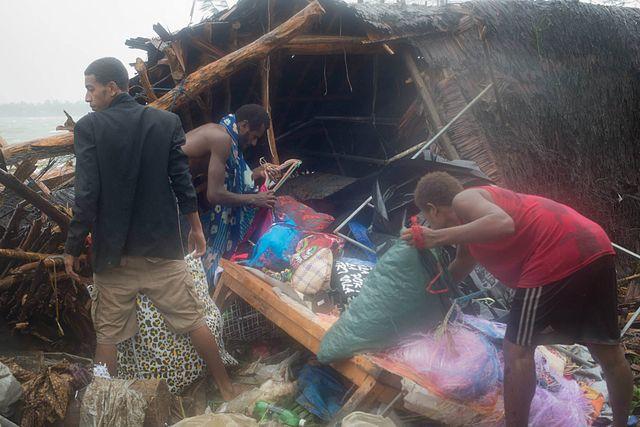
Supported by the Government of Japan, the March 25 workshop convened academics, practitioners and policy professionals from Australia, Japan, New Zealand, Pacific Islands countries and the US with expertise in regional dynamics, compound climate threats and disaster recovery mechanisms pertinent to the region.
In recent years, communities in the Pacific have experienced overlapping climate disasters, exemplified by the seven tropical cyclones and typhoons that cost multiple lives and billions of dollars in property damage in 2018. Warming temperatures have further contributed to drought, flooding, coral bleaching, wildfire and rising sea levels in the region, some of which has occurred at the same time.
Planning for Simultaneous Climate Disasters
In a panel focused on “Impacts of Compound Climate Threats,” Dr. Laura Brewington, a research fellow at the East-West Center and a lead investigator of NOAA’s Pacific Research on Island Solutions for Adaptation (RISA) and its Pacific Islands Climate, Health, and Migration Project, said healthy ecosystems and natural resources can help insulate communities from many of these threats, but they need protection and management. “Here in Hawai‘i and the Pacific, weʻve started to really focus on the interacting effects of climate change and biodiversity loss because our lives and livelihoods are so intertwined with our ecosystems," she said.
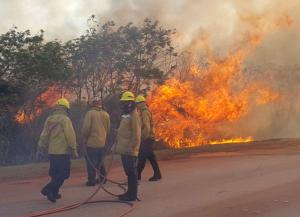
Photo courtesy of Guam Department of Agriculture, Forestry Division.
The Pacific Regional Invasive Species and Climate Change Management Network is among the regional efforts underway to address the interacting impacts of climate change and invasive species. Pacific RISCC gathers together scientists and natural resource managers to improve the ways that communities can anticipate and prepare for global warming and ecological change, said Brewington. Another regional initiative, the Pacific Invasives Partnership, has long worked on high-priority international invasive species issues, with members representing state and local institutions, non-governmental organizations and academia. The partners advocate for changes in the ways governments approach compound threats and stressors to ecosystems, she said.
Green Growth on Guam
Islands throughout the Pacific and beyond are responding to the challenges. Guam, for example, is a part of the Local2030 Islands Network, an international partnership created by the United Nations to implement its sustainable development goals at the local level. The networkʻs members include Hawai‘i and the Marshall Islands but also such faraway places as Ireland.
Guam has created a 97-member green growth working group with representatives from across sectors, businesses included, to address the UN goals in locally and culturally effective ways, said a sustainability expert from the island. (Under the workshop's "Chatham House rule," speakers are not identified by name unless they give their express permission.) "So now with the Guam Green Growth action framework, we have our islandʻs most comprehensive action plan ever created to achieve our sustainable future," the expert said.
He cited Guamʻs watershed initiative that is helping to restore the islandʻs coral reefs, which he described as having more species than seen in Hawai‘i or the Caribbean. Still, many of Guamʻs reefs are dying because of pollutants in erosion runoff and other climate impacts. As part of its watershed project, Guam is taking several steps to mitigate the erosion, among them testing drones to quickly spread seeds that can restore vegetation and slow the runoff.
Changing Fish Stock Distribution
Effects of climate change can be seen throughout the Pacific but with variations that call for tailoring the response to individual countries, said Mr. Masanori Kobayashi, senior fellow with the Sasakawa Peace Foundation’s Ocean Policy Research Institute, who studies blue economies tied to ocean resources.
Along with rising temperatures, typhoon activity and other signs of climate change, there are indications that fish stock distributions are changing, he said. In the mid- to long-term, reports point to a decline in available stock but with differences among subregions. "There may be a shift of fish stock distribution from west to east," Kobayashi said, with Micronesia projected to see fish catch declines and Polynesia to experience increases. Fish catch reports show these changes arenʻt happening currently, but he called for vigilance.
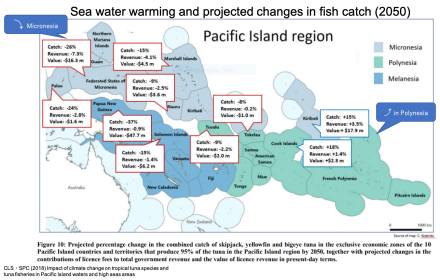
While conditions differ from country to country, Kobayashi urged that attention be paid to possible correlations involving drought, climate change and the pressures on agriculture and fisheries. When there is a drought, for example, farmers may move into fishing, stressing available stocks.
Brewington noted that for the time being, the economic recovery from COVID-19 will likely occupy the most attention, with less emphasis on issues like biodiversity and climate change. "But we can find ways to implement policies that effectively address these compounding factors in ways that are equitable without further entrenching marginalized communities," she said.
She said states and nations need to prioritize biodiversity in their stimulus packages, just as the European Commission has done, by incorporating compound stressors and adaptation in their recovery plans.
HONOLULU (April 7, 2021) -- Even as the COVID-19 pandemic remains the focus in the Pacific, compound threats increase the need for regional cooperation to address the mounting economic and environmental impacts from climate change, according to panelists at a recent East-West Center workshop on “Strengthening Resilience, Cooperation, and Partnership in the Pacific.”

Supported by the Government of Japan, the March 25 workshop convened academics, practitioners and policy professionals from Australia, Japan, New Zealand, Pacific Islands countries and the US with expertise in regional dynamics, compound climate threats and disaster recovery mechanisms pertinent to the region.
In recent years, communities in the Pacific have experienced overlapping climate disasters, exemplified by the seven tropical cyclones and typhoons that cost multiple lives and billions of dollars in property damage in 2018. Warming temperatures have further contributed to drought, flooding, coral bleaching, wildfire and rising sea levels in the region, some of which has occurred at the same time.
Planning for Simultaneous Climate Disasters
In a panel focused on “Impacts of Compound Climate Threats,” Dr. Laura Brewington, a research fellow at the East-West Center and a lead investigator of NOAA’s Pacific Research on Island Solutions for Adaptation (RISA) and its Pacific Islands Climate, Health, and Migration Project, said healthy ecosystems and natural resources can help insulate communities from many of these threats, but they need protection and management. “Here in Hawai‘i and the Pacific, weʻve started to really focus on the interacting effects of climate change and biodiversity loss because our lives and livelihoods are so intertwined with our ecosystems," she said.

Photo courtesy of Guam Department of Agriculture, Forestry Division.
The Pacific Regional Invasive Species and Climate Change Management Network is among the regional efforts underway to address the interacting impacts of climate change and invasive species. Pacific RISCC gathers together scientists and natural resource managers to improve the ways that communities can anticipate and prepare for global warming and ecological change, said Brewington. Another regional initiative, the Pacific Invasives Partnership, has long worked on high-priority international invasive species issues, with members representing state and local institutions, non-governmental organizations and academia. The partners advocate for changes in the ways governments approach compound threats and stressors to ecosystems, she said.
Green Growth on Guam
Islands throughout the Pacific and beyond are responding to the challenges. Guam, for example, is a part of the Local2030 Islands Network, an international partnership created by the United Nations to implement its sustainable development goals at the local level. The networkʻs members include Hawai‘i and the Marshall Islands but also such faraway places as Ireland.
Guam has created a 97-member green growth working group with representatives from across sectors, businesses included, to address the UN goals in locally and culturally effective ways, said a sustainability expert from the island. (Under the workshop's "Chatham House rule," speakers are not identified by name unless they give their express permission.) "So now with the Guam Green Growth action framework, we have our islandʻs most comprehensive action plan ever created to achieve our sustainable future," the expert said.
He cited Guamʻs watershed initiative that is helping to restore the islandʻs coral reefs, which he described as having more species than seen in Hawai‘i or the Caribbean. Still, many of Guamʻs reefs are dying because of pollutants in erosion runoff and other climate impacts. As part of its watershed project, Guam is taking several steps to mitigate the erosion, among them testing drones to quickly spread seeds that can restore vegetation and slow the runoff.
Changing Fish Stock Distribution
Effects of climate change can be seen throughout the Pacific but with variations that call for tailoring the response to individual countries, said Mr. Masanori Kobayashi, senior fellow with the Sasakawa Peace Foundation’s Ocean Policy Research Institute, who studies blue economies tied to ocean resources.
Along with rising temperatures, typhoon activity and other signs of climate change, there are indications that fish stock distributions are changing, he said. In the mid- to long-term, reports point to a decline in available stock but with differences among subregions. "There may be a shift of fish stock distribution from west to east," Kobayashi said, with Micronesia projected to see fish catch declines and Polynesia to experience increases. Fish catch reports show these changes arenʻt happening currently, but he called for vigilance.

While conditions differ from country to country, Kobayashi urged that attention be paid to possible correlations involving drought, climate change and the pressures on agriculture and fisheries. When there is a drought, for example, farmers may move into fishing, stressing available stocks.
Brewington noted that for the time being, the economic recovery from COVID-19 will likely occupy the most attention, with less emphasis on issues like biodiversity and climate change. "But we can find ways to implement policies that effectively address these compounding factors in ways that are equitable without further entrenching marginalized communities," she said.
She said states and nations need to prioritize biodiversity in their stimulus packages, just as the European Commission has done, by incorporating compound stressors and adaptation in their recovery plans.
Web Article
Recent online articles and analysis that have been published on the East-West Center website.






